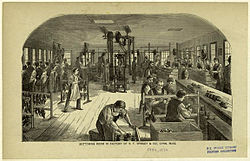Shoemaking

Shoemaking is the process of making footwear. Originally, shoes were made by handicraft. Few people buy shoes made by old-fashioned methods anymore, preferring cheaper ones made by industrial mass production. The old methods are still used for buyers who want unusually high quality. Shoemakers may produce a range of footwear items, including shoes, boots, sandals, clogs and moccasins. Such items are generally made of leather, wood, rubber, plastic, jute or other plant material.
A cordwainer is a shoemaker who makes very fine soft leather shoes. A cobbler is someone who repairs shoes.[1]
Shoemaking Media
A cordwainer making shoes, in Capri, Italy.
Roadside cobblers, Rekong Peo, Himachal Pradesh, India.
Roadside Lady Cobbler, in front of Kalighat Metro station gate, Kolkata, India.
Early shoemaking shop on exhibit at Maine State Museum in Augusta, Maine.
Romanian traditional shoemaking of opanak shoes, a type of moccasins
A shoemaker in the Georgian era, from The Book of English Trades, 1821.
By the late 19th century, the shoemaking industry had migrated to the factory and was increasingly mechanized. Pictured, the bottoming room of the B. F. Spinney & Co. factory in Lynn, Massachusetts, 1872.
References
- ↑ Driscoll, Michael; Meredith Hamiltion, and Marie Coons (May 2003). A Child's Introduction to Poetry. 151 West 19th Street New York, NY 10011: Black Dog & Leventhal Publishers. p. 12. ISBN 1-57912-282-5.
{{cite book}}: CS1 maint: location (link)
Other websites
![]() Media related to Shoemakers at Wikimedia Commons
Media related to Shoemakers at Wikimedia Commons






